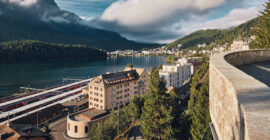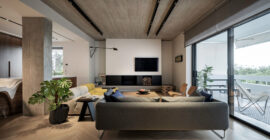Bordering Vienna’s Forest, in the suburb of Hietzing, the 1.400m² plot of land is situated along a street of detached residences with large gardens. The scheme aims at accommodating and negotiating the differing and ever changing needs of an extended family. Two predominant factors determined the structure’s mass and outline. On the one hand, the complex structural demands consisting of two independent residential units, an artist’s studio and a guest house and on the other the limitations that result from planning legislations concerning massing and land cover. The building is an urban villa with an austere three storey presence to the street, while the rear of the building spans two floors extending towards the garden is less so. Outdoors, the land’s topography was recast through a series of platforms that create structure, organising and facilitating outdoor living spaces in order to meet the residents’ needs. In terms of structural material, these specificities translated into a terraced black concrete base upon which sits the volume of the two storeys, enveloped with fixed and movable white, translucent Teflon panels. The fabric cladding was conceived as a reference to the quality and texture of the forgotten Bohemian tradition of linens. The transparency has an intense effect on the interiors as it draws in the precence of the neighbouring oak trees in the form of a game of shadows on the large canvases. From the street an alcove leads to the entrance. This niche leads to a spacious stairwell with a large skylight, which is the residence’s art gallery and the core of each home along the vertical axis, around which all rooms are arranged. Two everyday living spaces sit successively, different both in dimension and acoustic quality they lead out to the garden and are purpose designed to host music events and social gatherings with different capacities in mind. A level aperture from the ‘garden apartment’ leads to an enclosed patio with an oak tree, a reflective pool and an outdoor fireplace. The ‘upper’ apartment enjoys views towards the Vienna Forest, beyond the upper garden and the orchard to which it has direct, private access. At the initiation stage a strategy was carefully drawn out on energy efficiency and on eco-friendly function along with the architectural design. The result is a home that meets the highest building and energy efficiency standards (Niedrigenergiehaus) while it at the same time it benefits from the aesthetics of the large glazed surfaces and translucent cladding.
Design by:
Stephan Buerger, Dimitra Katsota, Tasos Govatsos
Photos by:
Jürgen Hammerschmied
https://images.ek-mag.com/wp-content/uploads/2017/04/vienni-4b.jpg
https://images.ek-mag.com/wp-content/uploads/2017/04/vienni-3b.jpg
https://images.ek-mag.com/wp-content/uploads/2017/04/vienni-1b.jpg
https://images.ek-mag.com/wp-content/uploads/2017/04/vienni-2b.jpg
https://images.ek-mag.com/wp-content/uploads/2017/04/vienni-6b.jpg
https://images.ek-mag.com/wp-content/uploads/2017/04/vienni-5b.jpg
https://images.ek-mag.com/wp-content/uploads/2017/04/vienni-7b.jpg
https://images.ek-mag.com/wp-content/uploads/2017/04/vienni-8b.jpg
https://images.ek-mag.com/wp-content/uploads/2017/04/vienni-9b.jpg
https://images.ek-mag.com/wp-content/uploads/2017/04/vienni-10b.jpg





